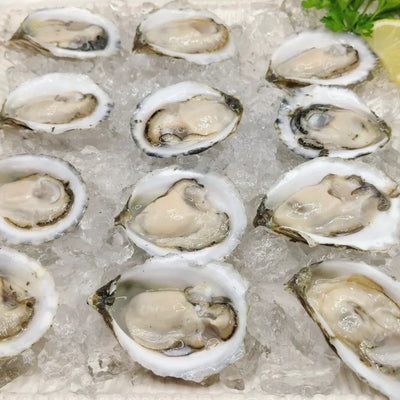Why do Oysters Taste Different?
Okay, you may have been wondering why almost every oyster you buy tastes different from the last. And rightly so!
There are over 150 varieties of oysters sold in North America alone. And notably, each oyster's flavor is a reflection of its local habitat. These tasty mollusks take on the flavors indigenous to the particular ocean or sea where they grow, as well as the general characteristics of the water body.
But although there are so many varieties of oysters, they all fall into 5 species. Each species has its own general flavor and characteristics, although there are also slight variations due to the habitat in which they grew.
So in this article, we will discuss the 5 species (or types) of oysters found in the US.
The 5 Types of Oysters
Pacific Oysters
The pacific oyster is known by several names such as Japanese oyster, creuse, and Miyagi. They're the most common type of oysters cultivated in the US Pacific Coast (hence the name), but they are not native to this region. They got to the US from the Asian Pacific in the 1900s.
The Pacific Oyster has a shell with naturally ruffled edges and is typically longer longitudinally than other types of oysters.
Like the rest species, Pacific Oysters come in different blends of flavor, but they have a sweeter, less salty taste than Atlantic Oysters. Some also have a creamy and honeydew taste.
Atlantic Oysters
Atlantic Oysters are native to North America and grow along the continent's Atlantic Coast and near the Gulf of Mexico. You'll easily differentiate them from Pacific Oysters as they tend to be significantly larger with a tear-drop shape. The shells are also smoother and more uniform in brown or forest green colors.
The taste of Atlantic Oysters is also distinctively brinier than Pacific Oysters but has a clean, mineral accent and savory finish.
Some people know the Atlantic Oysters as Virginia and Eastern Oysters.
Kumamoto Oysters
Some people call this type Kumi; others call it Kumo. As the name sounds, you'll easily guess they are brought for Japan. However, they're not nearly as popular in Japan as they are in the US.
Kumos are small and have deep bowl-like cups with artistically sculpted shells.
Their flavor is typically creamy or buttery, with a distinctive but mild nutty nuance and a honeydew finish. The mild taste makes it perfect for first-timers.
European Flat Oysters
Also known as Belon, the European Flat Oysters come with smooth saucer-like shells. The cup is shallow and has a seaweed-green appearance.
These will be a slightly hard one for freshers as they have the boldest flavors of all the oyster types. They come with a meaty, somewhat crunchy texture and a strong seaweed taste. But they're now a rare find due to over-harvesting.
Olympia Oysters
The Olympia Oysters are indigenous to the Pacific West Coast. Notably, they were once thought to be extinct until they emerged in the Pacific Northwest. But sadly, only a few farmers are cultivating them at the moment.
They're the smallest of all the oyster types and can take up to 4 years to be fully grown.
Yet, they have one of the most potent, overwhelming flavors. But if it's your first time trying out oysters, Olympia Oysters make a better first bite than European Flats.
They have a creamy texture with sweet celery and a slightly metallic top.
Whichever type of oyster you eat, there is one thing common among them all; you'd love to ask for more!









